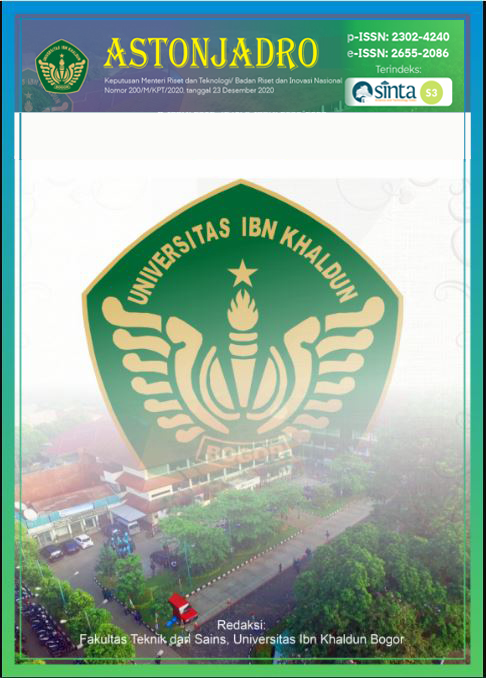Effect of fine modulus of coarse aggregate on the mechanical properties of concrete submerged in sea water
DOI:
https://doi.org/10.32832/astonjadro.v13i2.14907Keywords:
compressive strength; split tensile strength; flexural strength; concrete; coarse aggregate.Abstract
The durability of concrete can be determined from mixing coarse aggregate, fine aggregate, cement, water, with or without additives. The properties of concrete can be influenced by several things, such as the ratio of the mix, how to mix, how to transport, how to print, and how to compact. To analyze the compressive strength, flexural strength and split tensile strength of concrete submerged in sea water with variations in fineness modulus. The compressive strength results were 35.67Mpa, 31.63Mpa, 29.30Mpa respectively while the compressive strength of concrete with seawater immersion was 36.94Mpa, 36.52Mpa and 30.15Mpa. The split tensile strength results were 2.71Mpa, 2.65Mpa and 1.91MPa respectively, while the split tensile strength of concrete immersing in seawater with the same variations were 3.29MPa, 2.76MPa and 2.12MPa, respectively. The results of flexural strength were 4.22Mpa, 4.21Mpa, and 4.14MPa respectively, while the flexural strength of concrete with seawater immersion with the same variations were 4.27MPa, 4.22MPa, and 4.18MPa, respectively. The effect of fine grain modulus on compressive strength, split tensile strength and resulting flexural strength is very significant, the higher the fineness modulus of the coarse aggregate, the smaller the resulting value.
References
Ahmad, S.B. (2018) ‘Investigasi Pengaruh Air Laut Sebagai Air Pencampuran Dan Perawatan Terhadap Sifat Beton’, Intek: Jurnal Penelitian, 5(1), P. 48. Doi:10.31963/Intek.V5i1.200.
Arinata, A.S., Hidayat, M.T. And Wibowo, A. (2012) ‘Pengaruh Campuran Kadar Bottom Ash Dan Lama Perendaman Air Laut Terhadap Kuat Tekan Pada Silinder Beton’, 59, Pp. 1–11.
Asmara, F.J., Suhendra, S. And Dwiretnani, A. (2021) ‘Analisis Perbandingan Kuat Tekan Dan Kuat Tarik Beton Yang Menggunakan Pasir Sungai Batang Asai Dan Pasir Sungai Batanghari’, Jurnal Talenta Sipil, 4(1), P. 1. Doi:10.33087/Talentasipil.V4i1.42.
Besouw, G.V., Manoppo, M.R.E. And Palenewen, S.C.N. (2019) ‘Pengaruh Modulus Kehalusan Agregat Terhadap Penentuan Kadar Aspal Pada Campuran Jenis Ac-Wc’, Jurnal Sipil Statik, 7(4), Pp. 481–490.
Hunggurami, E., Utomo, S. And Wadu, A. (2014) ‘Pengaruh Masa Perawatan (Curing) Menggunakan Air Laut Terhadap Kuat Tekan Dan Absorpsi Beton’, Jurnal Teknik Sipil, 3(2), Pp. 103–110.
Khirunnisa, S., Rifqi, M.G. And Amin, M.S. (2019) ‘Kajian Kuat Tekan Beton Di Lingkungan Laut Tropis Banyuwangi’, Potensi : Jurnal Sipil Politeknik, 21(2), Pp. 47–53. Doi:10.35313/Potensi.V21i2.1583.
Mindrasari, P., Sambowo, K.A. And Basuki, A. (2014) ‘Pengaruh Curing Air Laut Pada Beton Mutu Tinggi Dengan Bahan Tambah Abu Sekam Padi Ditinjau Terhadap Kuat Tarik Belah Dan Modulus Of Rupture _ Mindrasari _ Matriks Teknik Sipil’, (September), Pp. 391–399.
Mulyadi, A., Suanto, P. And Meiza, R. (2020) ‘Analisis Kuat Tarik Belah Beton Pada Standar Kuat Tekan K200 Dengan Menggunakan Limbah Pecahan Tempurung Kelapa Sebagai Pengganti Agregat Kasar’, Jurnal Teknik Sipil, 10(2), Pp. 69–76. Doi:10.36546/Tekniksipil.V10i2.465.
Pandaleke, R.E. And Windah, R.S. (2017) ‘Perbandingan Uji Tarik Langsung Dan Uji Tarik Belah Beton’, Jurnal Sipil Statik, 5(10), Pp. 649–662.
Pujianto, A. Et Al. (2021) ‘Kuat Tekan Dan Tarik Belah Beton Serat Menggunakan Aggregat Ringan’, Semesta Teknika, 24(1), Pp. 1–9. Doi:10.18196/St.V24i1.12084.
Saputra, R.D. And Hepiyanto, R. (2017) ‘Pengaruh Air Pdam, Laut, Comberan Pada Proses Curing Terhadap Kuat Tekan Beton Fc 14,53 Mpa’, Jurnal Civila, 2(2), P. 6. Doi:10.30736/Cvl.V2i2.78.
Wibowo, W., Sunarmasto, S. And Rashad, H. (2019) ‘Kajian Kuat Tarik Langsung Dan Kuat Lekat Pada Beton Mutu Tinggi Memadat Mandiri Dengan Variasi Kadar Metakaolin’, Matriks Teknik Sipil, 7(4), Pp. 458–465. Doi:10.20961/Mateksi.V7i4.38486.
Wiranti, A.D. (2019) ‘Beton Slag Terhadap Variasi Perawatan ( Studi Eksperimental )’.
Erniati, M.W. Tjaronge, R. Djamaluddin and Victor Sampebulu. (2013) Consistency and Compressive Strength of Mortar using Seawater as mixing water. National Conference of Civil Engineering (KONTEKS 7). Vol. 1-M-33. (Indonesia).
Erniati, Tjaronge. M.W., R. Djamaluddin and Victor Sampebulu, (2014). Microstructure Characteristics of Self Compacting Concrete using Sea Water, International Journal of Applied Engineering Research (IJAER), Vol 9 No. 22 (2014) pp 18087-18095.
Artawan, I. P., Chaerul, M., & Gusty, S. (2023). Characterization of Oil and Diesel Waste Modifiers in Lasbutag Asphalt Cold Mix (Aggregated Buton Asphalt Layer). ASTONJADRO, 12(3), 823–829. https://doi.org/10.32832/astonjadro.v12i3.13868
Verdian, R., & Muin, R. B. (2023). The effect of variation in the length of water hyacinth fiber twisted on split tensile strength high performance fiber concrete. ASTONJADRO, 12(2), 546–557. httpBaggio, E. Y., Bagio, T. H., & Tistogondo, J. (2023). Mix design programming for normal concrete using cubic equation. ASTONJADRO, 12(1), 77–85. https://doi.org/10.32832/astonjadro.v12i1.7143s://doi.org/10.32832/astonjadro.v12i2.9346
Paikun, P., Amdani, S. A., Susanto, D. A., & Saepurrahman, D. (2023). Analysis of the compressive strength of concrete from brick wall waste as a concrete mixture. ASTONJADRO, 12(1), 150–162. https://doi.org/10.32832/astonjadro.v12i1.8145
Sitompul, S. T., & Pariatmono, P. (2022). Reliability of simple space truss structure. ASTONJADRO, 11(3), 600–607. https://doi.org/10.32832/astonjadro.v11i3.7399
Romadhon, E. S., Antonius, A., & Sumirin, S. (2022). Design of Low Alkali activator Geopolymer Concrete Mixtures. ASTONJADRO, 11(3), 627–638. https://doi.org/10.32832/astonjadro.v11i3.7484
Widodo, S., Safarizki, H. A., & Marwahyudi, M. (2022). Durability of concrete based on the remaining life of the building Case study: reinforced concrete in klaten district. ASTONJADRO, 11(3), 713–720. https://doi.org/10.32832/astonjadro.v11i3.7848
Downloads
Published
How to Cite
Issue
Section
License
Copyright (c) 2024 ASTONJADRO

This work is licensed under a Creative Commons Attribution-ShareAlike 4.0 International License.
Paper submitted to ASTONJADRO is the sole property of the Astonjadro Journal. Unless the author withdraws the paper because he does not want to be published in this journal. The publication rights are in the journal Astonjadro.ASTONJADRO
LICENSE
This work is licensed under a Creative Commons Attribution-ShareAlike 4.0 International License.
Based on a work at http://ejournal.uika-bogor.ac.id/index.php/ASTONJADRO













